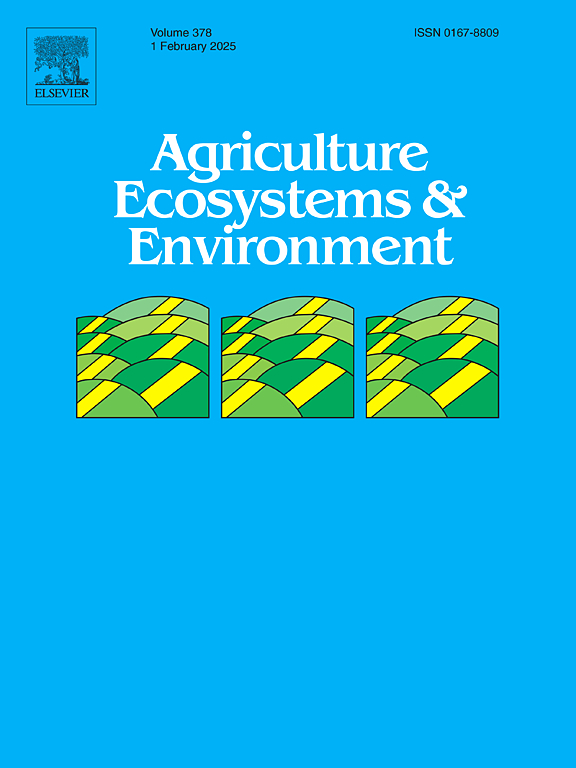Below-ground biodiversity in agricultural systems: The role of crop-specific management in shaping soil arthropod communities
IF 6
1区 农林科学
Q1 AGRICULTURE, MULTIDISCIPLINARY
引用次数: 0
Abstract
Soil arthropod communities play a crucial role in ecosystem functioning, yet their response to agricultural land use and management practices remains poorly understood. This study aims to assess (i) soil biological quality, (ii) arthropod biodiversity, and (iii) community structure across different agricultural systems, evaluating the effects of soil management strategies (organic, integrated, conservative). A total of 414 sampling areas were investigated (during spring and, where the same crop was maintained, autumn, in the years 2019 and 2022) across arable land, vineyards, orchards, and grasslands, with soil properties characterization (texture, humidity, bulk density) and soil arthropods extracted and identified to the order or class level. The QBS-ar and QBS-c indices, Shannon diversity (H’), and Pielou’s Evenness (J) were used to evaluate soil biological quality and community structure. Results indicate that agricultural management significantly influences soil biological quality and arthropod abundance. Organic management improved biodiversity and QBS-ar in alfalfa and cereals but not in leguminous crops. Vineyards exhibited higher arthropod densities than arable land, where soil biological quality was most impacted. Seasonal variation influenced community structure, but not diversity indices. Specific arthropod taxa correlated with distinct land uses, with Pseudoscorpionidae, Isopoda, and Protura associated with vineyards, while Myriapoda, Diplura, and Hymenoptera thrived in organically managed alfalfa. These findings highlight the role of agricultural management in shaping soil arthropod communities and emphasize the need for crop-specific management approaches to enhance soil biodiversity and ecosystem services.
农业系统中的地下生物多样性:特定作物管理在塑造土壤节肢动物群落中的作用
土壤节肢动物群落在生态系统功能中起着至关重要的作用,但它们对农业土地利用和管理措施的响应仍然知之甚少。本研究旨在评估(i)土壤生物质量,(ii)节肢动物多样性,(iii)不同农业系统的群落结构,评估土壤管理策略(有机、综合、保守)的效果。共调查了414个采样区(春季和秋季,2019年和2022年保持相同作物),包括耕地、葡萄园、果园和草地,土壤特性表征(质地、湿度、体积密度),提取并鉴定了土壤节肢动物的目或类水平。采用QBS-ar和QBS-c指数、Shannon多样性(H′)和Pielou均匀度(J)评价土壤生物质量和群落结构。结果表明,农业管理对土壤生物质量和节肢动物数量有显著影响。有机管理改善了苜蓿和谷类作物的生物多样性和QBS-ar,但对豆科作物没有改善。葡萄园节肢动物密度高于耕地,对土壤生物质量影响最大。季节变化影响群落结构,但不影响多样性指数。特定节肢动物类群与不同的土地利用方式相关,假蝎目、等足目和原足目与葡萄园相关,而多足目、双足目和膜翅目在有机管理的紫花苜蓿中大量繁殖。这些发现强调了农业管理在塑造土壤节肢动物群落中的作用,并强调了采用针对特定作物的管理方法来增强土壤生物多样性和生态系统服务的必要性。
本文章由计算机程序翻译,如有差异,请以英文原文为准。
求助全文
约1分钟内获得全文
求助全文
来源期刊

Agriculture, Ecosystems & Environment
环境科学-环境科学
CiteScore
11.70
自引率
9.10%
发文量
392
审稿时长
26 days
期刊介绍:
Agriculture, Ecosystems and Environment publishes scientific articles dealing with the interface between agroecosystems and the natural environment, specifically how agriculture influences the environment and how changes in that environment impact agroecosystems. Preference is given to papers from experimental and observational research at the field, system or landscape level, from studies that enhance our understanding of processes using data-based biophysical modelling, and papers that bridge scientific disciplines and integrate knowledge. All papers should be placed in an international or wide comparative context.
 求助内容:
求助内容: 应助结果提醒方式:
应助结果提醒方式:


